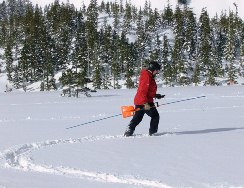
The skier and snowboarder caught in an avalanche near Haines last week were experienced back country riders. They were among six who accessed Takhine Ridge by helicopter. The guide, who died at the scene, worked for Alaska Heli-skiing, and was trained and certified by the Alaska Helicopter Skiing Association.
Both men were recovered by other skiers and snowboarders using avalanche beacons.
In Juneau, backcountry users can practice their rescue skills at the Avalanche Beacon Training Park at Eaglecrest Ski Area.
Rosemarie Alexander visited the park with Eaglecrest’s Snow Safety Directors on a blustery day.
“When you’re out in the back country, your friend gets caught in a slide. That’s not the time to get the instruction book out – now how does this work?”
Eaglecrest Ski Patrolman Dale Gosnell has seen it happen before. Backcountry enthusiasts buy the right gear but don’t know how to use it.
“It’s important to have an avalanche transceiver, shovel, probe, skills and a partner with those skills,” Gosnell says.
In a year of near record snowfall in the mountains around Juneau, skiers and snowboarders are easily lured to the backcountry.
The Avalanche Beacon Training Park is the place to practice using the gear that’s required for safe travel.
The so-called Easy Searcher is mounted on a pole beside Raven Runout at Cropley Flats. It’s powered by lithium batteries, recharged by a solar panel above. Six radio-controlled units, each about the size of a small briefcase, are buried beneath the snow in an area about the size of a soccer field. Those pads simulate buried victims wearing an avalanche transceiver.
The machine has three search modes, each with increasing difficulty. Davies sets it on “easy,” and it indicates that one avalanche victim is buried somewhere in the area.
“Get your probe ready,” Davies says, as he snaps it in place.
He turns on his transceiver. Goznell makes sure his transceiver is off.
“Otherwise you’re looking for each other,” Davies says.
Avalanche transceivers send out electromagnetic flux lines in every direction. Searchers follow those signals to the beacon that’s transmitting from the buried victim.
Davies and Goznell start hiking through the heavy snow.
“Unlike a real avalanche where you have a last seen point, we don’t have one, so we need to set up our gross search pattern as we walk across, trying to find our initial signal, Davies says.
Cropley Flats soon begins to feel like a big place. Davies and Gosnell hike in one direction than another. Still no beeps.
“I’m just kind of probing over in a circle,” Davies says, about 10 centimeters between each probe strike.”
The pace quickens and it appears Davies has a signal. He stops and probes deep into the snow. His avalanche transceiver is telling him he’s getting closer to the victim. Gosnell joins him and they reach the victim. The Easy Searcher is beeping and a yellow light is flashing. When the last victim is found, it beeps three times.
If this had been a real avalanche, the chances of survival decrease dramatically after 15 minutes. It took Davies just over 11 minutes. In a real-life situation, the next step is digging out the victim.
“Statistically, the average burial depth in U.S. is eight-tenths of a meter, or right about three feet. They say the average time to move a cubic meter or cubic yard of snow, three feet by three feet by three feet, is about 10 minutes. If you are doing a multiple search none of the beacons turn off until you have found them all. So it makes you think, because you can’t turn off somebody’s beacon until they’ve been excavated out of the snow,” Davies says.
The Avalanche Beacon Training Park was funded by the Alaska Search and Rescue Association, or ASARA. It’s a collaboration of Eaglecrest, the National Ski Patrol, Juneau Mountain Rescue, SEADOGS and ASARA.
The portable rugged unit is used in training by mountain rescue groups throughout Southeast.
Alyeska Ski Resort in Girdwood also has a portable unit.
Eaglecrest Snow Safety Director Davies says there’s no substitute for practice if you’re traveling in the backcountry. He has coined a phrase for Southeast’s snowpack: Maritime Complacency.
“Our snowpack kind of leads us into getting away with a lot of stuff. But when it does go, it tends to go pretty big,” he says. “And we don’t want anybody hurt. We want people out there to enjoy. So come practice.”
